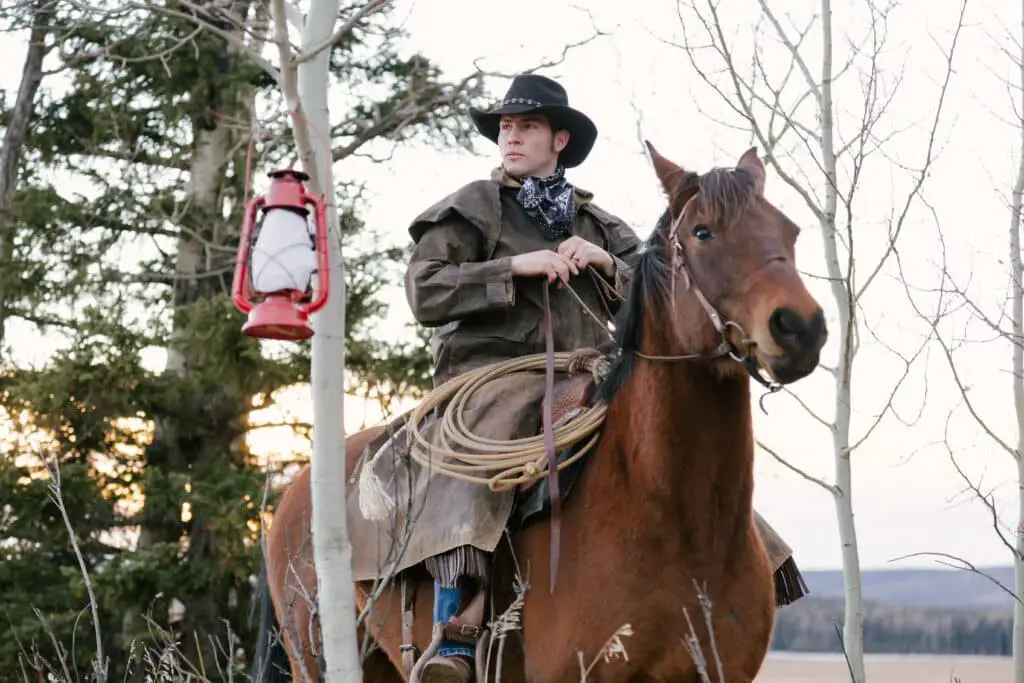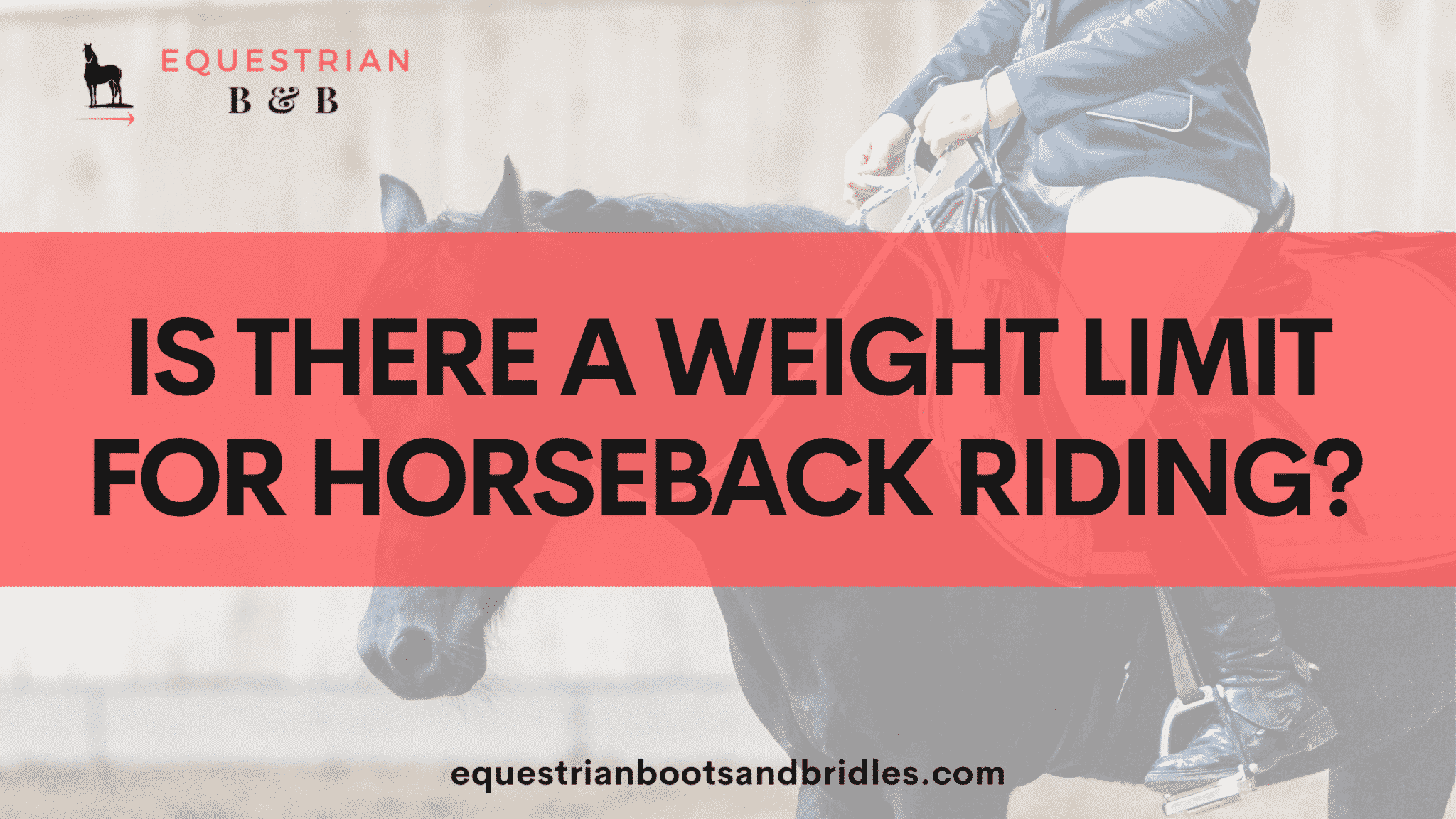Horseback riding is a thrilling experience, but the benefits run deeper than just recreation and fun. Burning calories, heart health, strengthening core muscles, boosting mood, and improving mental health are just a few merits of horseback riding. However, before you get on the saddle and trot away with your steed, it’s crucial to ensure you’re in the right weight range.
Is there a weight limit for horseback riding?
Indeed, as strong as the equines may appear, they do have a rider weight limit range that shouldn’t be exceeded. Even the stocky drafts reared mainly for hard labor such as farming, logging, and other cart-pulling purposes have weight limits, above which performance is compromised.
What Is the Maximum Horseback Riding Weight Limit? (How Much Weight Can a Horse Carry?)
Several studies have been done to find the physiological responses of horses at varying rider weights. Almost every study conducted concluded that a horse can comfortably carry 20% of its body weight. For instance, a pony weighing 900 pounds should not carry a load (rider plus saddle) weighing more than 180 pounds.
When you visit most horse riding stables, they limit riders’ weight to 250lbs. However, some horses can carry up to 400 pounds. But on average, most of the horses on the higher load range are drafts, which can weigh up to 2000 pounds or slightly above.

Factors Affecting Horse Carrying Capacity
A horse’s weight is the main factor affecting its carrying capacity. But that’s not the only thing that can affect a horse’s ability to carry heavy loads. In addition to the steed being able to comfortably accommodate you, the saddle, and any other items you might have with you (if you’re going for a longer ride), there are some other equally important factors that may impact how much a horse can carry. Some of these things include:
Horse’s Build
A horse’s build is one of the determinants of how much weight it can bear without sustaining injuries. For the most part, stocky horses with strong bones and decent back length can endure more weight better than those with shorter backs and weaker builds.
On the same note, horses with wider cannon bone circumference have better carrying capacity than those with smaller bones.
Horse’s Fitness
Physically fit horses also bear body weight better. For instance, an active horse that’s regularly active (going on rides, working, or generally running around!) can generally carry a heavier rider more comfortably than a similar-sized horse that spends most of the time locked up.
Terrain Conditions
If a horse is used to flat terrain, it might experience more difficulties ferrying the same weight under rough (rocky or mountainous) terrain, mostly due to fatigue.
Right Equipment
A well-fitting saddle allows for balanced weight distribution, making it possible for the horse to carry a rider comfortably. In addition, it eliminates risks such as nerve pinching and muscle soreness, which are likely to get worse with excessive weight.
Horse Breed
A horse’s breed is also a major determinant of how much weight it can carry. For instance, a draft or Belgian is sturdier than a thoroughbred or a highland pony. As a result, drafts and Belgians carry heavier riders more comfortably than their latter counterparts.
Hoof Care
Well-trimmed hooves allow for balanced weight distribution on the feet, making it more comfortable for the horse to bear rider weight. When not properly cared for, uneven hooves increase the risk of injury (back, joint, and muscle damage; lameness; etc.) due to uneven weight distribution.
For this reason, regular hoof care (which may include trimming or fitting appropriate horse boots) is essential to enhance a horse’s carrying capacity.
To learn more about the basics of horse hoof care, check out this article.
Horse’s Age
The horse’s age may also affect how much weight it can bear. Generally, older horses carry more weight than younger steeds. Of course, once a horse gets well into its advanced years, their ability to bear as much weight will likely begin to decline again.
Rider’s Experience and Fitness
An experienced or physically fit rider can manage their bodyweight well, allowing for uniform distribution on the saddle, unlike an inexperienced or unfit rider who is likely to slouch on the saddle, making it difficult for the horse to carry them comfortably.
Horse’s Experience
A well-trained horse will likely be able to navigate a heavy rider more easily than a green horse can. This is basically just because the horse is going to have more experience carrying different kinds of riders, it’s going to be a more well-muscled horse, and it’s just generally going to be more skilled at controlling its body when navigating different landscapes on a trail ride, responding to rider cues, etc.

Risks of Overburdening a Horse
It’s vital to know how much your horse can carry as it allows you to monitor riders’ weight easily. Having a rough estimate of your horse’s carrying capacity lets you know who can and cannot ride, which goes a long way in eliminating the risks associated with exceeding weight limits.
Common risks of exceeding a horse’s weight limit include:
- Soreness – When a rider is too heavy for a horse, they exert excessive pressure against the saddle, causing rub-sores on the horse’s back. In addition, their excess weight damage the horse’s muscles and nerves, leading to soreness.
- Temperament Issues – No matter how friendly and well-trained a horse is, overburdening it may cause it to become tired, stressed, and irritable from the pain. As a result, it could become uncontrollable, heightening the risk of falling, especially for inexperienced riders.
- Deteriorated Health – As the horse gets overburdened repeatedly, it might suffer permanent damage to the back, muscles, joints, and other stressed organs. Over time, it can develop lameness and balance problems.
- Reduced performance – Whether you rear your horse for work, hiring out, or sport, overstressing it can affect its performance. For instance, it might be too dangerous for trainees or leisure riders to use it if it develops temperament issues. Deteriorated health could also adversely affect its performance, especially if it’s used for sport or work purposes.
Frequently Asked Questions

1. Is there a simpler way of telling whether a horse can carry me?
Certainly, if you know how much a horse weighs, all you need is to add up your weight plus saddle and then determine if they are below 20% of the horse weight.
For instance, if you weigh 150lbs, the saddle weighs 30lbs, and the horse is approximately 1000lbs. 20% of the horse’s body weight is 200lbs, which is higher than your weight plus the saddle combined. This means the equine can carry you safely.
If you don’t know the horse’s weight, you can use this calculator to get an estimate. Ideally, the calculator uses the horse’s girth and length measurements to estimate the weight. So you just need to take the horse’s dimensions, enter them in the calculator, and it gives you an approximate weight figure.
2. What are the possible horse breeds for heavy riders?

Horse types range from the small miniatures and ponies to the stocky drafts. Heavier riders require breeds on the higher weight range as they have the build (bone strength and back size) to support heavy loads comfortably. Some of the most common breeds in this category include:
- Percheron – Over 1800lbs
- Belgian – Over 1800lbs
- Shire – Over 1500lbs
- Clydesdale – Over 1500lbs
- Irish draught – Over 1300lbs
- Friesian – Over 1300lbs
3. Can excess rider weight cause a fall?
When you are too heavy for a horse, the risk of falling is always present. However, this might not necessarily be caused by skewed balance (because the horse’s center of mass is below the saddle) as long as you can manage your weight well.
But for an inexperienced rider unable to balance properly on the saddle, they might end up falling easily, especially since their weight is already overwhelming the horse.
Other times, the falls might be caused by the horse’s reaction to the discomfort of too much pressure on the back. In addition, if the rider is unfit and unable to mount smoothly without agitating the horse, a slight jerking from the steed might result in a fall accident.
4. Can my build affect my ability to ride a horse?
It may or may not! As much as it’s essential not to overburden your horse by ensuring your weight is below 20% of its body weight, if you’re unfit and unable to manage your weight on the saddle, riding might prove challenging even if you fall below its carrying capacity.
On the other hand, taller people tend to have better weight distribution than shorter people bearing the same weight. Hence, your BMI may also determine how comfortably you can ride a horse, especially if you’re an inexperienced rider.
5. Can being overweight hinder a horse’s carrying capacity?
Yes. If a horse is out of shape, especially due to lack of regular exercise, it might not be strong enough to endure loads even within its carrying capacity. Bearing too much bodyweight exerts excess pressure on the feet, joints, and muscles, leading to poor performance. For instance, strong hooves are essential for balanced weight distribution; hence, when the hoof wall gets damaged, the horse cannot bear weights comfortably.
However, you can always help your horse get back in shape through regular activities such as riding, hill work, walking, lunging, interval training, etc.
Conclusion
We all know that the conversation around weight can be a prickly one, and it can cause anxiety for many. We never want to “fat-shame” anyone and we of course believe that anyone and everyone should be able to experience the benefits of riding horses!
The purpose of this article is simply to present the different things that larger people should consider when riding in order to keep their horse healthy and prevent any injury, chronic pain, or joint problems for their horse. This way you can find the right horse for you!
Also, remember that weight is not always just about fat. A very tall and muscular man, for example, could fall outside of that 20% range of a horse’s weight.
If you have been wondering whether there is a weight limit for horseback riding, we hope this article has addressed your concerns.
The key things to remember are:
- Ensure your weight and the saddle weight do not exceed 20% of the horse’s body weight
- Consider other things such the horse’s build, fitness, breed, and age, terrain conditions, equipment, hoof condition, plus your experience and fitness.
Factoring all these unique determinants is essential in keeping yourself safe while protecting your horse from reduced performance, temperament issues, deteriorated health, soreness, and other associated risks.


I am shocked and disgusted about the trail rides in the South. Overweight unfit riders on too young too small horses spur and beat them to race on asphalt streets. It breaks my heart! Is there no Vet on side who stops this abuse? Is nobody evaluate the condition of the horses before these fat guys and women climb onto the saddles? If you do t believe me- watch those videos on YouTube- it is terrible and I don’t understand why it is not illegal. The horses are malnourished and in pain, the heaviest riders have the biggest whips and spurs, lean back in the saddle and pull on the reins so the horse gets the signal to stop- at the same time they drive them to race…. How can this be stopped?!?!?!